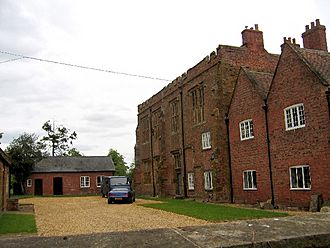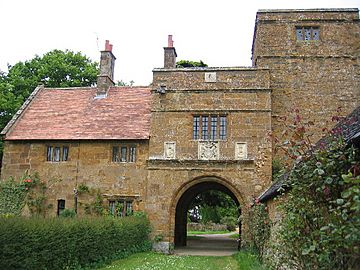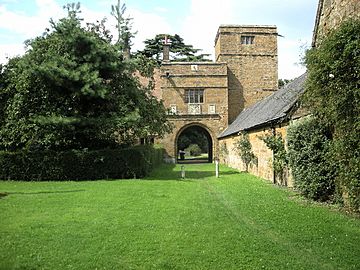Wormleighton Manor facts for kids
Quick facts for kids Wormleighton Manor |
|
|---|---|

Wormleighton Manor
|
|
| General information | |
| Architectural style | Tudor |
| Town or city | Wormleighton, Warwickshire |
| Country | England |
| Coordinates | 52°10′48″N 1°20′44″W / 52.18°N 1.345556°W |
| Completed | 1512 |
| Demolished | 1645 |
Wormleighton Manor is a large, old country house in Wormleighton, England. It was once owned by the very rich Spencer family in the 1500s and 1600s. Sadly, much of the manor was burned down in 1645 during the English Civil War. The Spencer family then moved to another home called Althorp in Northamptonshire. Today, only a few parts of Wormleighton Manor remain. These include the old gatehouse, a small building called Tower Cottage, and a northern section of the main house. The gatehouse and cottage are now protected as a Grade II listed building.
Contents
The Manor's Story
Wormleighton Manor is a great example of Tudor style architecture. This building style was popular when King Henry VIII ruled England. The wealthy Spencer family became linked to Wormleighton in 1469. They made their money by selling wool in the 1400s.
How the Spencers Built Their Fortune
The Spencer family started small. John Spencer became a "feoffee" (like a landlord) in 1469. His nephew, also named John, was smart with money. He traded animals and other goods. He saved enough to buy the lands at Wormleighton and Althorp.
Wormleighton was bought in 1506. The main manor house was finished in 1512. The family's wealth grew a lot. John Spencer bought the land at Althorp between 1509 and 1511. He built another home there too.
Changes and a Famous Library
In 1613, a gatehouse was added to Wormleighton Manor. Sir Robert Spencer, the first Lord Spencer, built it. He or his son also made the main house bigger. The Spencer family collected many books at the manor. This collection became a huge library. It is now kept in London.
The English Civil War and Its Impact
In 1645, a big event changed everything. Royalist soldiers from nearby Banbury set fire to Wormleighton Manor. They did this to stop it from being used by the Parliament's army. The fire caused a lot of damage.
Because of this, the Spencer family left Wormleighton Manor. They made Althorp their main home instead. Althorp is still the Spencer family's home today. Some parts of Wormleighton Manor were saved. For example, oak wood panels from Wormleighton were moved to Althorp. Stained glass windows were also moved there in the 1800s.
Inspiration for Another Home
In 1925, an American couple visited Wormleighton Manor. They were Alexander and Virginia Weddell. They wanted ideas for a new home they were building. They had bought an old Tudor manor in England. They were shipping it to Richmond, Virginia, in the United States. The eastern part of their new home, called Virginia House, was finished in 1929. It is said to be based on the design of Wormleighton Manor.
What Remains Today
Most of Wormleighton Manor is gone. But some important parts still stand.
The Historic Gatehouse
The gatehouse was built in 1613. It stands about 30 meters south of where the main house was. It has two floors and is made of yellow stone. It is a protected building. The archways are about 3.3 meters high. On the south side, they have old flower carvings and a sundial.
The Spencer family's coat of arms is on the north and west sides. It has a dragon and a griffin. The royal Stuart family's coat of arms is on the south side. These carvings are from 1613.
Inside the gateway, there are doorways in the side walls. The lower west lodge has a red tiled roof. It is about 8.2 meters long and has two floors. There is also an east tower next to the gateway. It is about 4.9 meters wide. It has a window with four sections on the lower part.
There are also remains of another two-story building. It is about 24 meters further south. People think it was once part of the stable buildings. Today, it is a modern farm building.
Images for kids




